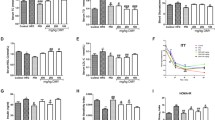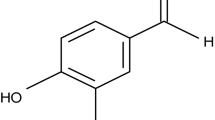Abstract
In this study, the in vivo effects of insulin and chronic treatment with bis(maltolato)oxovanadium (IV) (BMOV) on protein kinase B (PKB) activity were examined in the liver and skeletal muscle from two animal models of diabetes, the STZ‐diabetic Wistar rat and the fatty Zucker rat. Animals were treated with BMOV in the drinking water (0.75–1 mg/ml) for 3 (or 8) weeks and sacrificed with or without insulin injection. Insulin (5 U/kg, i.v.) increased PKBα activity more than 10‐fold and PKBβ activity more than 3‐fold in both animal models. Despite the development of insulin resistance, insulin‐induced activation of PKBα was not impaired in the STZ‐diabetic rats up to 9 weeks of diabetes, excluding a role for PKBα in the development of insulin resistance in type 1 diabetes. Insulin-induced PKBα activity was markedly reduced in the skeletal muscle of fatty Zucker rats as compared to lean littermates (fatty: 7‐fold vs. lean: 14‐fold). In contrast, a significant increase in insulin‐stimulated PKBa activity was observed in the liver of fatty Zucker rats (fatty: 15.7‐fold vs. lean: 7.6‐fold). Chronic treatment with BMOV normalized plasma glucose levels in STZ‐diabetic rats and decreased plasma insulin levels in fatty Zucker rats but did not have any effect on basal or insulin‐induced PKBα and PKBβ activities. In conclusion (i) in STZ‐diabetic rats PKB activity was normal up to 9 weeks of diabetes; (ii) in fatty Zucker rats insulin‐induced activation of PKBα (but not PKBβ) was markedly altered in both tissues; (iii) changes in PKBα activity were tissue specific; (iv) the glucoregulatory effects of BMOV were independent of PKB activity.
Similar content being viewed by others
References
Kahn CR: Insulin action, diabetogenes, and the cause of type II diabetes. Diabetes 43: 1066–1084, 1994
Saltiel AR: Diverse signaling pathways in the cellular actions of insulin. Am J Physiol Endocrinol Metab 270: E375–E385, 1996
DeFronzo RA: The triumvirate: β-cell, muscle, liver: A collusion responsible for NIDDM. Diabetes 37: 667–687, 1988
Yki-Järvinen H, Koivisto VA: Natural course of insulin resistance in type 1 diabetes. N Engl J Med 315: 224–230, 1986
Yki-Järvinen H, Sahlin K, Ren JM, Koivisto VA: Localization of ratelimiting defect for glucose disposal in skeletal muscle of insulin-resistant type 1 diabetic patients. Diabetes 39: 157–167, 1990
Ziel FH, Venkatesan N, Davidson MB: Glucose transport is rate limiting for skeletal muscle glucose metabolism in normal and STZ-induced diabetic rats. Diabetes 37: 885–890, 1988
Hei YJ: Recent progress in insulin signal transduction. J Pharmacol Toxicol Meth 40: 123–135, 1998
Halse R, Rochford JJ, McCormack JG, Vandenheede JR, Hemmings BA, Yeaman SJ: Control of glycogen synthesis in cultured human muscle cells. J Biol Chem 274: 776–780, 1999
Yeh JI, Gulve EA, Rameh L, Birnbaum MJ: The effects of wortmannin on rat skeletal muscle. J Biol Chem 270: 2107–2111, 1995
Lazar DF, Wiese RJ, Brady MJ, Mastick CC, Waters SB, Yamauchi K, Pessin JE, Cuatrecasas P, Saltiel AR: Mitogen-activated protein kinase kinase inhibition does not block the stimulation of glucose utilization by insulin. J Biol Chem 270: 20801–20807, 1995
Lavoie L, Band CJ, Kong M, Bergeron JJM, Posner BI: Regulation of glycogen synthase in rat hepatocytes. J Biol Chem 274: 28279–28285, 1999
Kohn AD, Summers SA, Birnbaum MJ, Roth RA: Expression of a constitutively active Akt Ser/Thr kinase in 3T3-L1 adipocytes stimulates glucose uptake and glucose transporter 4 translocation. J Biol Chem 271: 31372–31378, 1996
Turinsky J, Damrau-Abney A: Akt kinases and 2-deoxyglucose uptake in rat skeletal muscles in vivo: Study with insulin and exercise. Am J Physiol Reg Integ Comp Physiol 276: R277–R282, 1999
Ueki K, Yamamoto-Honda R, Kaburagi Y, Yamauchi T, Tobe K, Burgering BMT, Coffer PJ, Komuro I, Akanuma Y, Yazaki Y, Kadowaki T: Potential role of protein kinase B in insulin-induced glucose transport, glycogen synthesis, and protein synthesis. J Biol Chem 273: 5315–5322, 1998
Sekar N, Li J, Shechter Y: Vanadium salts as insulin substitutes: Mechanisms of action, a scientific and therapeutic tool in diabetes mellitus research. Crit Rev Biochem Mol Biol 31: 339–359, 1996
Blondel O, Bailbe D, Portha B: In vivo insulin resistance in streptozotocin-diabetic rats-evidence for reversal following oral vanadate treatment. Diabetologia 32: 185–190, 1989
Ramanadham S, Mongold JJ, Brownsey RW, Cros GH, McNeill JH: Oral vanadyl sulfate in treatment of diabetes mellitus in rats. Am J Physiol Heart Circ Physiol 257: H904–H911, 1989
Brichard SM, Pottier AM, Henquin JC: Long term improvement of glucose homeostasis by vanadate in obese hyperinsulinemic fa/fa rats. Endocrinology 125: 2510–2516, 1989
Cohen N, Halberstam M, Shlimovich P, Chang CJ, Shamoon H, Rossetti L: Oral vanadyl sulfate improves hepatic and peripheral insulin sensitivity in patients with non-insulin-dependent diabetes mellitus. J Clin Invest 95: 2501–2509, 1995
Bhanot S, McNeill JH: Vanadyl sulfate lowers plasma insulin and blood pressure in spontaneously hypertensive rats. Hypertension 24: 625–632, 1994
Bhanot S, McNeill JH, Bryer-Ash M: Vanadyl sulfate prevents fructose-induced hyperinsulinemia and hypertension in rats. Hypertension 23: 308–312, 1994
Elberg G, He Z, Li J, Sekar N, Shechter Y: Vanadate activates membranous nonreceptor protein tyrosine kinase in rat adipocytes. Diabetes 46: 1684–1690, 1997
Shisheva A, Shechter Y: Role of cytosolic tyrosine kinase in mediating insulin-like actions of vanadate in rat adipocytes. J Biol Chem 268: 6463–6469, 1993
Poucheret P, Verma S, Grynpas MD, McNeill JH: Vanadium and diabetes. Mol Cell Biochem 188: 73–80, 1998
McNeill JH, Yuen VG, Hoveyda HR, Orvig C: Bis(maltolato)oxovanadium (IV) is a potent insulin mimic. J Med Chem 35: 1489–1491, 1992
Matsuda M, DeFronzo RA: Insulin sensitivity indices obtained from oral glucose tolerance testing. Diabetes Care 22: 1462–1470, 1999
Shulman GI, Rothman DL, Jue T, Stein P, DeFronzo RA, Shulman RG: Quantitation of muscle glycogen synthesis in normal subjects and subjects with non-insulin-dependent diabetes by 13C nuclear magnetic resonance spectroscopy. N Engl J Med 322: 223–228, 1990
Shepherd PR, Nave BT, Rincon J, Haigh RJ, Foulstone E, Proud C, Zierath JR, Siddle K, Wallberg-Henriksson H: Involvement of phosphoinositide 3-kinase in insulin stimulation of MAP-kinase and phosphorylation of protein kinase-B in human skeletal muscle: Implications for glucose metabolism. Diabetologia 40: 1172–1177, 1997
Moule SK, Denton RM: Multiple signaling pathways involved in the metabolic effects of insulin. Am J Cardiol 80: 41A–49A, 1997
Wijkander J, Holst LS, Rahn T, Resjö S, Castan I, Manganiello V, Belfrage P, Degerman E: Regulation of protein kinase B in rat adipocytes by insulin, vanadate, and peroxovanadate. J Biol Chem 272: 21520–21526, 1997
Konishi H, Matsuzaki H, Tanaka M, Ono Y, Tokunaga C, Kuroda S, Kikkawa U: Activation of RAC-protein kinase by heat shock and hyperosmolarity stress through a pathway independent of phosphatidylinositol 3-kinase. Proc Natl Acad Sci USA 93: 7639–7643, 1996
Konishi H, Matsuzaki H, Tanaka M, Takemura Y, Kuroda S, Ono Y, Kikkawa U: Activation of protein kinase B (Akt/RAC-protein kinase) by cellular stress and its association with heat shock protein Hsp27. FEBS Lett 410: 493–498, 1997
Sable CL, Filippa N, Hemmings B, Van Obberghen E: cAMP stimulates protein kinase B in a wortmannin-insensitive manner. FEBS Lett 409: 253–257, 1997
Donthi RV, Huisamen B, Lochner A: Effects of vanadate and insulin on glucose transport in isolated adult rat cardiomyocytes. Cardiovasc Drugs Ther 14: 463–470, 2000
Mohammad A, Bhanot S, McNeill JH: In vivo effects of vanadium in diabetic rats are independent of changes in PI-3 kinase activity in skeletal muscle. Mol Cell Biochem (in press)
Ionescu E, Sauter JF, Jeanrenaud B: Abnormal oral glucose tolerance in genetically obese (fa/fa) rats. Am J Physiol Endocrinol Metab 248: E500–E506, 1985
Kasiske BL, O'Donnell MP, Keane WF: The Zucker rat model of obesity, insulin resistance, hyperlipidemia, and renal injury. Hypertension 19(suppl I): I-110–I-115, 1992
Anai M, Funaki M, Ogihara T, Terasaki J, Inukai K, Katagiri H, Fukushima Y, Yazaki Y, Kikuchi M, Oka Y, Asano T: Altered expression levels and impaired steps in the pathway to phosphatidylinositol 3-kinase activation via insulin receptor substrates 1 and 2 in Zucker fatty rats. Diabetes 47: 13–23, 1998
Björnholm M, Kawano Y, Lehtihet M, Zierath JR: Insulin receptor substrate-1 phosphorylation and phosphatidylinositol 3-kinase activity in skeletal muscle from NIDDM subjects after in vivo insulin stimulation. Diabetes 46: 524–527, 1997
Krook A, Kawano Y, Song XM, Efendić S, Roth RA, Wallberg-Henriksson H, Zierath JR: Improved glucose tolerance restores insulinstimulated Akt kinase activity and glucose transport in skeletal muscle from diabetic Goto-Kakizaki rats. Diabetes 46: 2110–2114, 1997
Krook A, Roth RA, Jiang XJ, Zierath JR, Wallberg-Henriksson H: Insulin-stimulated Akt kinase activity is reduced in skeletal muscle from NIDDM subjects. Diabetes 47: 1281–1286, 1998
Kim YB, Nikoulina SE, Ciaraldi TP, Henry RR, Kahn BB: Normal insulin-dependent activation of Akt/protein kinase B, with diminished activation of phosphoinositide 3-kinase, in muscle in type 2 diabetes. J Clin Invest 104: 733–741, 1999
Kurowski TG, Lin Y, Luo Z, Tsichlis PN, Buse MG, Heydrick SJ, Ruderman NB: Hyperglycemia inhibits insulin activation of Akt/protein kinase B but not phosphatidylinositol 3-kinase in rat skeletal muscle. Diabetes 48: 658–663, 1999
Kim YB, Peroni OD, Franke TF, Kahn BB: Divergent regulation of Akt1 and Akt2 isoforms in insulin target tissues of obese Zucker rats. Diabetes 49: 847–856, 2000
Schmoll D, Walker KS, Alessi DR, Grempler R, Burchell A, Guo S, Walther R, Unterman TG: Regulation of glucose-6-phosphatase gene expression by protein kinase Bá and the forkhead transcription factor FKHR. J Biol Chem 275: 36324–36333, 2000
Sutherland C, Waltner-law M, Gnudi L, Kahn BB, Granner DK: Activation of the Ras mitogen-activated protein kinase-ribosomal protein kinase pathway is not required for the repression of phosphoenolpyruvate carboxykinase gene transcription by insulin. J Biol Chem 273: 3198–3204, 1998
Liao J, Barthel A, Nakatani K, Roth RA: Activation of protein kinase B/Akt is sufficient to repress the glucocorticoid and cAMP induction of phosphoenolpyruvate carboxykinase gene. J Biol Chem 273: 27320–27324, 1998
Galetic I, Andjelkovic M, Meier R, Brodbeck D, Park J, Hemmings BA: Mechanism of protein kinase B activation by insulin/insulin-like growth factor-1 revealed by specific inhibitors of phosphoinositide 3-kinase - significance for diabetes and cancer. Pharmacol Ther 82: 409–425, 1999
Author information
Authors and Affiliations
Corresponding author
Rights and permissions
About this article
Cite this article
Marzban, L., Bhanot, S. & McNeill, J.H. In vivo effects of insulin and bis(maltolato)oxovanadium (IV) on PKB activity in the skeletal muscle and liver of diabetic rats. Mol Cell Biochem 223, 147–157 (2001). https://doi.org/10.1023/A:1017943200785
Issue Date:
DOI: https://doi.org/10.1023/A:1017943200785




